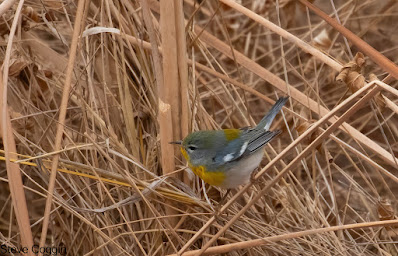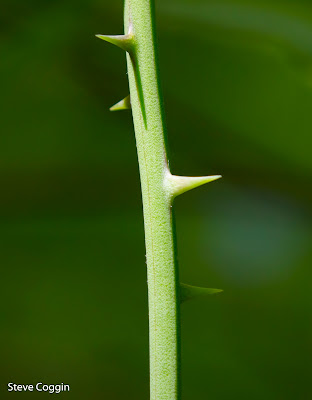 |
| Prothonotary Warbler (Protonotaria citrea). Rowan County, North Carolina. |
Spring is coming and birds that spent the winter in the tropics are heading north. The most eagerly awaited of these neotropical migrants are the new world warblers, the Parulidae. These small birds are active, often brightly colored and each sings a distinctive song. This family has 117 species and all are restricted to the New World. Many warblers are tropical but over 35 species regularly occur in eastern North America.
 |
| Pine Warbler (Setphaga pinus). Rowan County, North Carolina. |
Pine Warblers (Setophaga pinus) are present
year-round of the Piedmont of North Carolina.
As their name suggests they are closely associated with pines (Pinus
sp.) where they feed, breed and nest. Yellow-rumped Warblers (Setophaga coronata) migrate
from the north and spend the cold months with us. This species breeds in northern forests and
winters throughout the south and into the tropics. Yes, Yellow-rumped Warblers do have yellow rumps. This gives rise to
their nickname, butterbutts.
 |
| Male Yellow-rumped Warbler (Setophaga coronata) in spring. Rowan County, North Carolina. |
 |
| Female Yellow-rumped Warlber in winter, showing her yellow rump, Rowan County, North Carolina. |
Other warblers arrive from the south in the spring and breed in our area. One of the first of these early birds is the Louisiana Waterthrush (Parkesia motacilla). Despite the thrush in its name, this bird is really a warbler. Both male and female Louisiana Waterthrushes are brown on the back with a white eye line and a white breast with brown streaks. They also have the habit of bobbing their tails while perched or walking on the ground. Male Louisiana Waterthrushes sing on their breeding territory near water in hopes of attracting a mate.
 |
| Louisiana Waterthrush (Parkesia motacilla) singing in spring. Mecklenburg County, North Carolina. |
Common Yellowthroats (Geothylpis trichas) are warblers that breed near creeks, ponds and marshes. Males have a black mask, a brilliant yellow throat and brown back. Females have similar coloration but lack the black mask. Males sit on exposed perches and sing their distinctive song, witchity-witchity-witch.
 |
| Male Common Yellowthroat (Geothlypis trichas). Rowan County, North Carolina. |
American Redstart (Setophaga ruticilla) males are
brilliantly colored, black with flashes of orange on the wings and tail. Females are grayish brown and with yellow markings. These active warblers are constantly fluttering
among the leaves and fanning their tails while chasing insects. American Redstarts will chase insects through
the air and often look like falling leaves as they pursue their prey.
 |
| Male American Redstart (Setophaga ruticilla). Palm Beach County, Florida. |
The Black-and-white Warbler (Mniotilta varia) has a very descriptive name. These warblers are striped black and white and behave like little woodpeckers, crawling along tree trunks and branches looking for food.
 |
| Male Black-and-white Warbler (Mniotilta varia). Dry Tortugas National Park, Florida. |
The smallest warbler we have in the area is the Northern Parula (Setophaga americana). This tiny creature is brightly colored with blue on the back, yellow on the throat and breast and an orange collar. Northern Parulas have white wing bars, a broken white circle around the eyes and a green saddle on the backs. They build their hanging nests high in trees. Northern Parulas use of lichens as nest material in our area, but further south they make their nests with Spanish Moss.
Yellow-throated Warblers (Setophaga dominica) are
boldly patterned black, white and yellow birds. Males and females have similar plumage and they spend their time
creeping along branches in search of their insect prey.
 |
| This Yellow-throated Warbler (Setophaga dominica) was hanging around our bird feeders and acting sick. It tumbled to the ground and died later that day. Rowan County, North Carolina. |
Ovenbirds (Seiurus aurocapilla) are warblers with strikingly large eyes and spend a lot of time on the ground. They look like tiny thrushes with a gray-green back, white breast with black stripes and a crown streaked with orange. Ovenbirds get their name from their dome-shaped nest. They build nests on the ground that resemble an old-fashioned clay oven with a side entrance. This ground nesting habit makes their eggs and young vulnerable to predators like snakes, squirrels and chipmunks.
 |
| Ovenbird (Seiurus aurocapilla) feeding on the ground. Mecklenburg County, North Carolina. |
 |
| Ovenbird. Mecklenburg County, North Carolina. |
I think the most dazzling member of the Parulidae is the Prothonotary Warbler (Protonotaria citrea). Prothonotaries are bright yellow and seem to glow with an internal light in their swamp habitat. They are one of only two cavity nesting warblers and use old woodpecker holes or nest boxes. Their odd name comes has an ecclesiastical source. The First Notary (proto-notary) was a Catholic Church official who traditionally wore yellow robes. When Europeans started naming North American birds, they found a red-robed Cardinal and, yes, a yellow-robed Prothonotary. Our friend Dr. Joe Poston is doing a long-term study on Prothonotary Warblers in Salisbury, North Carolina. He traps the birds and marks them with colored leg bands. Each bird has a unique combination of colors so they can be identified through binoculars. In the spring of 2021 we found a male Prothonotary singing on his territory. Based on his legs bands this warbler was at least 5 years old. The oldest known Prothonotary lived 8 years. We hope to find this guy singing again this spring on his way to breaking that record.
 |
| Prothonotary Warbler bringing food to nestlings. Rowan County, North Carolina. |
 |
| A male Prothonotary Warbler with colored leg bands. This bird was at least five years old in the spring of 2021. Rowan County, North Carolina. |
There are so many warblers, and I will not be able to cover them all. But the next blog with have another selection of these most appealing birds.












